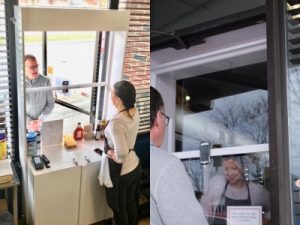New Image of Home:
Online Lecture and Catalogue
Johan Voordouw, artist and professor at the Azrieli School of Architecture & Urbanism, unpacks New Image of Home in a lecture on YouTube.
New Image of Home is the culmination of a two-year research project into the evolution of the Canadian home and its visual representation. It is based on an analysis of 325 residential projects – single-family home and small multi-unit buildings– published in Canadian Architect magazine from its inception in 1956 to 2017. The houses appear in every corner of the country, though Toronto and Vancouver comprise about one-third of the data set.
Here’s a link to the catalogue: NIH_Catalogue_200323 The research is expressed in three related projects. The first is an analysis of the interior photographs of the houses. The second is a study of the floor plans. The third is a research-creation project to develop a new way of digitally drawing architecture.
The research is expressed in three related projects. The first is an analysis of the interior photographs of the houses. The second is a study of the floor plans. The third is a research-creation project to develop a new way of digitally drawing architecture.

The analysis of the photographs revealed some compelling changes over time. Some of these changes are obvious, e.g., the removal of ashtrays. Others are more subtle, like the shift from a regular couch, conducive for talking, to an ‘L’ shaped sofa, which is better for lounging. All of these changes, large and small, speak to the continued evolution of the Canadian home and its use.
There are also changes in how the photographs are composed. The composition has shifted from a two-point perspective to a more frontal one-point perspective, with the vanishing point and horizon line central to the image. This contemporary view tends to isolate the spaces and downplay their adjacencies to other rooms in the house. It suggests architecture as a curated set of individual moments as opposed to a sequence of related spaces.
 In the analysis of the floor plans, Voordouw discovered more than 200 room names used to describe the interior spaces of the home. Some speak to the unique desires of the client for a ballet or hockey room. Others reveal the evolution of the home. For example, secondary spaces that were once called billiards, games, and recreation rooms became audio-visual, TV, entertainment, and, more recently, media rooms.
In the analysis of the floor plans, Voordouw discovered more than 200 room names used to describe the interior spaces of the home. Some speak to the unique desires of the client for a ballet or hockey room. Others reveal the evolution of the home. For example, secondary spaces that were once called billiards, games, and recreation rooms became audio-visual, TV, entertainment, and, more recently, media rooms.
Here is a window to the changes in the social space of the home from physical interaction towards media. They point to what is considered home entertainment over the years and how Canadians wish to experience it.
 Voordouw developed 24 drawings that used the image analysis and spatial research as a foundation for subverting the representation of the contemporary home in print and online publications. The house used in the images is unique enough to be published but generic enough to be anywhere. The drawings aim to challenge the idea of the perfect, curated image. In this home, there are cups left on the coffee table, toys under the television stand, and laptops and other devices scattered about.
Voordouw developed 24 drawings that used the image analysis and spatial research as a foundation for subverting the representation of the contemporary home in print and online publications. The house used in the images is unique enough to be published but generic enough to be anywhere. The drawings aim to challenge the idea of the perfect, curated image. In this home, there are cups left on the coffee table, toys under the television stand, and laptops and other devices scattered about.
 These things are visible, but the method of drawing makes them fuzzy, hidden, ghostly. The drawings are embroidered, backlit, and drawn using dots instead of lines or rendered
These things are visible, but the method of drawing makes them fuzzy, hidden, ghostly. The drawings are embroidered, backlit, and drawn using dots instead of lines or rendered
It started as a desire to develop a series of dot drawings breaking the hegemony of the architectural line and surface as a means of spatial representation. A reconceptualization of the digital pixel as a dot causes the fuzziness. Voordouw manipulates and varies the shape and size of the dot to develop an image where the drawing ebbs between materialization and dissipation.

New Image of Home moves away from the photo-realistic fidelity of the architectural render to examine a softer, more layered approach to domestic space. This approach counters the sterile narrative of design magazines and online publications. The drawings try to undermine typical images either in their use of unconventional media or by revealing what architectural images usually try to hide – the mundane, sometimes messy reality of domestic life.
 “I hope that these drawings expand architectural visualization away from the perfection of the curated image to embrace the every-day and improve the physical environment in which its occupants live their daily lives,” says Voordouw.
“I hope that these drawings expand architectural visualization away from the perfection of the curated image to embrace the every-day and improve the physical environment in which its occupants live their daily lives,” says Voordouw.
An exhibition of the digital drawings is hanging in the Lightroom Gallery in the Architecture Building at Carleton University until April 8. Unfortunately, access is limited due to CV19 restrictions.
About Johan Voordouw
Johan Voordouw is an Associate Professor at the Azrieli School of Architecture & Urbanism and a registered architect in the UK.
I have been interested in architecture since early childhood. I have decades of sketchbooks littered with drawings of buildings and castles, and my basement was full of Lego and Playmobil. After high school, I attended the University of Manitoba for my undergraduate degree and, after two years of practice, moved to London, England to attend graduate school at the Bartlett School of Architecture, University College London. The Bartlett was a remarkable school that defines to this day how I think about architectural drawing. It was not until I started working at Carleton University; however, that I began to consider more carefully the social concerns related to the profession and the agency the built environment has to improve our world.
The first drawing project completed while working at Carleton University was entitled Weerkas (2014) and considered climate change in the Netherlands. These 12 drawings were extensively published and exhibited in Canada, the United States, Austria, and the Netherlands, including the International Architecture Biennale in Rotterdam, and the Academy of Fine Arts in Vienna.
The New Image of Home set of drawings will be the foundation for a forthcoming book to be published in 2021. Moving forward, I aim to continue my research-creation work with an interest in spatial occupation and environment and a critique of the contemporary architectural image.


